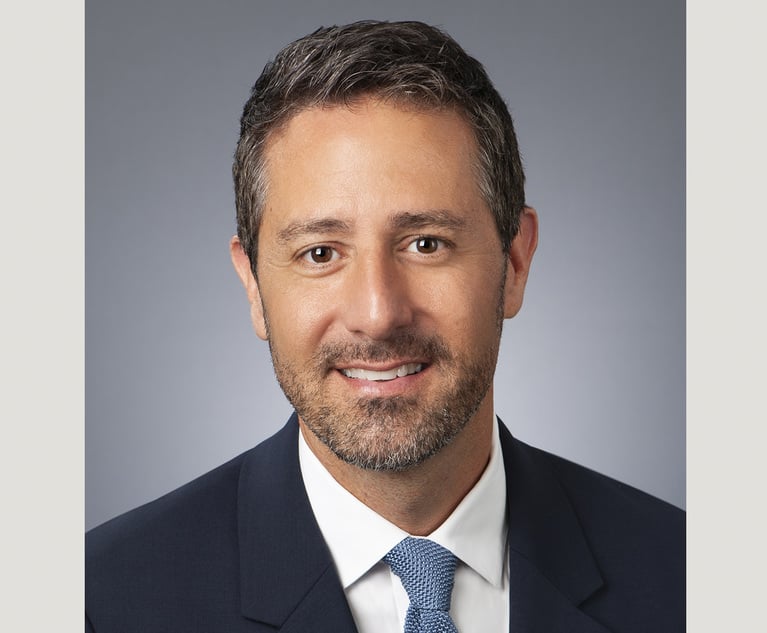Midwest Mania? What's Behind the Biggest Law Firm Mergers of 2019
The geography may stand out, but the business pressures driving a flurry of midwest mergers are familiar to law firms everywhere.
November 07, 2019 at 03:35 PM
6 minute read
 Law firms expanding in the Midwest are finding Minneapolis especially irresistible. Photo: Shutterstock
Law firms expanding in the Midwest are finding Minneapolis especially irresistible. Photo: Shutterstock
The spate of merger activity in the past three months was driven, in part, by the same forces that have been pushing law firms to scale up for decades.
What stands out is the geography: The largest U.S. mergers announced in 2019 have all been in the Midwest, according to data collected by consultancy Altman Weil.
Law firm leaders and legal consultants involved in the latest combinations—Taft Stettinius & Hollister's union with Briggs and Morgan, Dentons combining with Bingham Greenebaum Doll and Cohen & Grigsby, and a deal between Lathrop Gage and Gray Plant Mooty—indicated that the firms are responding to client pressure to simultaneously grow and deepen their specialist ranks.
Apart from Dentons—a 10,000-lawyer global juggernaut that wants to expand in smaller U.S. markets—these firms have between 100 and 400 lawyers. That wasn't enough for some of the Midwestern firms' key clients, who for years had been telling their counsel, "show us how deep your areas of specialization are," said Kristin Stark, a principal at Fairfax Associates who worked on the Lathrop GPM merger.
"Partially because they're getting compared to large firms that have a lot of depth and specialization, it's very difficult to win clients over when you only have one or two lawyers doing something," Stark said. "That's really opened up firms in the midsize range … it's really opened them up to growth in a way they weren't open to in the past because their clients are demanding."
The deals are part of a "major realignment" that's being driven by upper middle-market clients and talent, said Steven Ryan, the president and managing partner of Minneapolis firm Briggs and Morgan—soon to be part of Cincinnati-based Taft.
Ryan said firms aren't just facing pressure from their clients to scale up, but from lawyers as well. If partners don't believe a firm will provide the best platform to attract clients and build their books of business, they will go elsewhere, Ryan said. He recalled how Briggs and Morgan had difficulty replacing partners who had retired because the firm hadn't attained adequate scale to compete with other, larger firms.
"Going to the most talented lawyers in our market and saying, 'Hey, come to a Minneapolis-only, 140-lawyer firm' was becoming an increasingly difficult thing to sell," Ryan said.
Even doubling in size—going from 140 lawyers to 280 lawyers—wouldn't have solved the firm's client-facing and talent-facing scaling dilemmas, Ryan said.
"The reason we picked Taft specifically is we wanted to solve both the client-facing dilemma we had and the talent-facing dilemma we had," Ryan said.
R. Cameron Garrison, the managing partner of Lathrop Gage who will lead Lathrop GPM, echoed the importance of a scale. The firms' merger, he said, will "position us to better serve our clients and offer better depth and breadth in our practice area."
A Fertile Midwest or Minneapolis Mania?
Although consolidation pressures are being faced by law firms of all sizes in all areas, a number of consultants noted that the Midwest is especially fertile ground because there are more merger opportunities—and markets are less saturated—than in places like New York, Los Angeles or even Chicago.
"I think the key on why we're seeing more deals partly has to deal with the fact that, in addition to everything else, the Midwest is less picked over than some other markets, like markets on the coast, like attractive markets in Texas," said Kent Zimmermann, a consultant at Zeughauser Group who worked on the two Dentons combinations.
"There are still more high-quality firms in the Midwest that haven't been approached as often and haven't already combined with other firms and may be willing to consider it," he said,
Altman Weil principal Tom Clay offered a similar view, describing an "evolution" in the geography of law firm mergers.
Both Zimmermann and Clay noted that Taft, Briggs, Lathrop and Gray Plant Mooty all shared similar characteristics—market types, size, practices—that bolster their chances of carrying out a successful merger. Zimmermann added that law firms, for their first big merger, usually combine with a firm that is similar to them in terms of culture, geography, size and practices.
"Law firms are often more comfortable in their first significant deal in not doing it so far away from home," Zimmermann said.
But Stark questioned whether these mergers were driven by the legal market conditions of the Midwest, and not just Minneapolis. She pointed out that the Taft and Lathrop mergers involve larger firms merging with smaller ones in an effort to gain access to the Minneapolis legal market.
"I don't know if this is an overall Midwest growth story as much as a reflection of the fact that Minneapolis is an attractive legal market and firms are really interested in growth," Stark said.
The virtues of Minneapolis—its low costs, strong talent pool and abundance of upper middle-market corporations—have been attracting attention. But Stark said there is a "decent gap" between the Minneapolis legal market and its counterparts in the Midwest, with the exception of the Chicago mega-market. Minneapolis is growing, while some of the other legal markets in the Midwest have not been.
"Part of the Midwest story is that Minneapolis is a secondary Chicago, in many ways. In terms of the business space, if you're not going to be in Chicago or Chicago is really challenging, Minneapolis is a great next stop," Stark said.
Read More
Dentons Chases Big 4′s Footprint With New US Strategy
Why Firms Keep Flocking to 'Perfect' Minneapolis
Midwest Merger Makes Taft an Am Law 100 Contender
Lathrop Inks Merger With Minnesota Firm as Midwest Stays Hot
Market Focus Indianapolis: A 'Game Changer' For the Circle City?
This content has been archived. It is available through our partners, LexisNexis® and Bloomberg Law.
To view this content, please continue to their sites.
Not a Lexis Subscriber?
Subscribe Now
Not a Bloomberg Law Subscriber?
Subscribe Now
NOT FOR REPRINT
© 2025 ALM Global, LLC, All Rights Reserved. Request academic re-use from www.copyright.com. All other uses, submit a request to [email protected]. For more information visit Asset & Logo Licensing.
You Might Like
View All
'Ridiculously Busy': Several Law Firms Position Themselves as Go-To Experts on Trump’s Executive Orders
5 minute read
Holland & Knight Hires Former Davis Wright Tremaine Managing Partner in Seattle
3 minute read
Am Law 200 Firms Announce Wave of D.C. Hires in White-Collar, Antitrust, Litigation Practices
3 minute read
Paul Hastings Hires Music Industry Practice Chair From Willkie in Los Angeles
Trending Stories
Who Got The Work
J. Brugh Lower of Gibbons has entered an appearance for industrial equipment supplier Devco Corporation in a pending trademark infringement lawsuit. The suit, accusing the defendant of selling knock-off Graco products, was filed Dec. 18 in New Jersey District Court by Rivkin Radler on behalf of Graco Inc. and Graco Minnesota. The case, assigned to U.S. District Judge Zahid N. Quraishi, is 3:24-cv-11294, Graco Inc. et al v. Devco Corporation.
Who Got The Work
Rebecca Maller-Stein and Kent A. Yalowitz of Arnold & Porter Kaye Scholer have entered their appearances for Hanaco Venture Capital and its executives, Lior Prosor and David Frankel, in a pending securities lawsuit. The action, filed on Dec. 24 in New York Southern District Court by Zell, Aron & Co. on behalf of Goldeneye Advisors, accuses the defendants of negligently and fraudulently managing the plaintiff's $1 million investment. The case, assigned to U.S. District Judge Vernon S. Broderick, is 1:24-cv-09918, Goldeneye Advisors, LLC v. Hanaco Venture Capital, Ltd. et al.
Who Got The Work
Attorneys from A&O Shearman has stepped in as defense counsel for Toronto-Dominion Bank and other defendants in a pending securities class action. The suit, filed Dec. 11 in New York Southern District Court by Bleichmar Fonti & Auld, accuses the defendants of concealing the bank's 'pervasive' deficiencies in regards to its compliance with the Bank Secrecy Act and the quality of its anti-money laundering controls. The case, assigned to U.S. District Judge Arun Subramanian, is 1:24-cv-09445, Gonzalez v. The Toronto-Dominion Bank et al.
Who Got The Work
Crown Castle International, a Pennsylvania company providing shared communications infrastructure, has turned to Luke D. Wolf of Gordon Rees Scully Mansukhani to fend off a pending breach-of-contract lawsuit. The court action, filed Nov. 25 in Michigan Eastern District Court by Hooper Hathaway PC on behalf of The Town Residences LLC, accuses Crown Castle of failing to transfer approximately $30,000 in utility payments from T-Mobile in breach of a roof-top lease and assignment agreement. The case, assigned to U.S. District Judge Susan K. Declercq, is 2:24-cv-13131, The Town Residences LLC v. T-Mobile US, Inc. et al.
Who Got The Work
Wilfred P. Coronato and Daniel M. Schwartz of McCarter & English have stepped in as defense counsel to Electrolux Home Products Inc. in a pending product liability lawsuit. The court action, filed Nov. 26 in New York Eastern District Court by Poulos Lopiccolo PC and Nagel Rice LLP on behalf of David Stern, alleges that the defendant's refrigerators’ drawers and shelving repeatedly break and fall apart within months after purchase. The case, assigned to U.S. District Judge Joan M. Azrack, is 2:24-cv-08204, Stern v. Electrolux Home Products, Inc.
Featured Firms
Law Offices of Gary Martin Hays & Associates, P.C.
(470) 294-1674
Law Offices of Mark E. Salomone
(857) 444-6468
Smith & Hassler
(713) 739-1250










